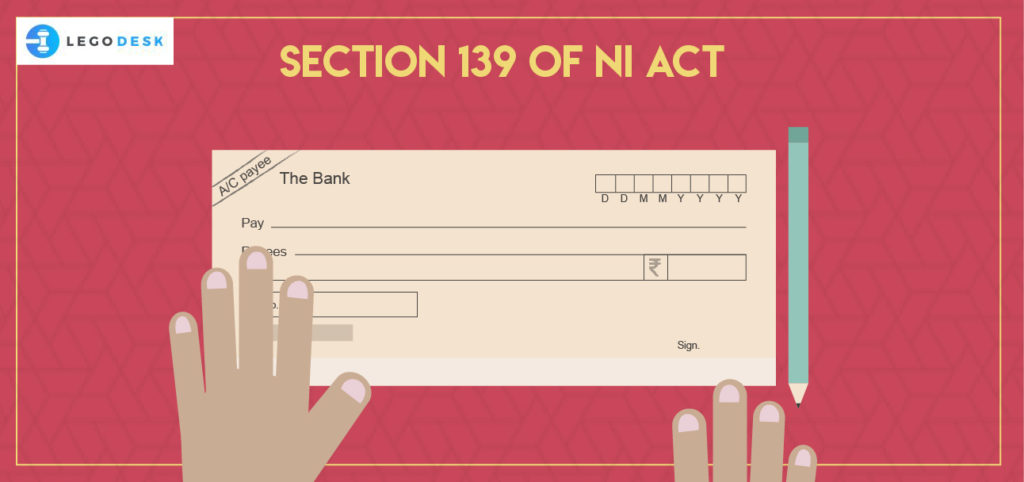Section 139 of Negotiable Instruments Act

A cheque is defined as a bill of exchange drawn on a specified banker and not expressed to be payable otherwise than on demand. There are three essential parties to a cheque: The Drawer of a cheque, the drawee of a cheque, and the payee of a cheque. On Section 138 negotiable instruments act Supreme Court judgments have time and again highlighted various important provisions. Every year holiday under the negotiable instruments act is declared and a cheque cannot be presented on a holiday.
The new insertion of chapter XVII in the Negotiable Instruments Act, 1881[1] to define the liabilities of a drawer of a dishonored-cheques. Parliament with the aim to restore the credibility on the cheques to be used as a trustworthy medium inserted sections 138 and 139.[2] In the recent amendments in the negotiable instruments act, section 143A was inserted which provides for interim compensation in case of an offense under section 138.
Section 139 of Negotiable Instruments act, 1881
As per the prevailing laws in India, under the Indian Evidence Act, every person until proven guilty is presumed to be innocent. Section 139 of the Negotiable Instruments Act, 1881 talks about the liability of a person who is issuing a cheque that has been dishonored. Such a person is presumed to be guilty until and unless he proves his innocence. When an offense under section 138 is constituted, there is a set of admitted facts and situations where it is presumed that the person is guilty.[3]
In Krishi Vikas Kendra v Mukund[4], the amount due was paid partly by the accused. This amounts to a transaction made and the court held that the burden of proof is on the accused to prove his innocence with respect to dishonored cheque.
Under section 139 there is a presumption that a cheque presented is for a discharge of the liability of debt either partially or wholly. And until and unless the respondent purposes any purpose other than the discharge of liability, it shall be presumed under section 138.[5] The accused person cannot merely escape by saying it was only given as security and the day cheque was issued there was no liability towards the person.[6]
Once the presumption of liability is rebutted, the burden of proof shifts to the complainant to prove that the same cheque was issued for discharge of liability.[7] In the case of Rangappa v. Sri Mohan[8], it was held that if to any fact the accused has not replied in the statutory notice (notice under section 138) proves to be a merit for the complainant side.
This presumption is governed by the rule of evidence which is dealt by in section 118(a) of chapter XIII. Section 140 talks about the possible grounds which may not be allowed as a ground of defense for prosecution under section 138.
In the case of Krishna Janardhan Bhat v. Dattatraya G. Hedge[9],
“Presumption of innocence as human rights and the doctrine of reverse burden which is granted under section 139 should be balanced with respect to the facts of each case, material evidence on record and governing statutes of law.”[10]
For it is a presumption only with regard to existing debts. So, if the amount on the cheque exceeds the amount which is due to the person, then section 138 and section 139 shall not be attracted, this was held in the case of Angu Parameswari Textiles P Ltd. v. Sri Rajan and co.[11]
On the reading of this section, it is pertinent to highlight that court that is taking cognizance should be prima facie satisfied that the case is attracted under this section. The drawer of the cheque gets a chance to rebut this presumption at the trial.[12]
In the case of Kishan Rao v. Shankargouda[13], the SC held that section 1309 cannot be merely rebutted by denial. It has to be proved. The matter in controversy shall be proven to be denied with evidence.
This presumption is however not available to a money lender. He has to prove the fact of due of loan and liability through other evidence and not merely by a presumption of being guilty.[14]
The initial burden after discharge, Section 139 comes into the picture. In the case of A.B.M raja Sah v. B.M.S. Srinivas Sah[15], it was held that once signatures on the cheque were verified by the drawer and he s presumption arose and the accused couldn’t explain the liability. The court ordered the accused to pay twice the amount of the cheque and no sentence was passed.
CONCLUSION
When a cheque which was issued for discharge of liability or debt whether in whole or in part, shall under section 139 be presumed that the accused is liable for the offense under section 138 and thus the accused is under the burden of proof to prove its innocence.
[1] Added by the Banking, Public Financial Institutions and Negotiable Instruments Laws (Amendment) Act, 1988
[2] Goa Plast (P) Ltd. V. Chico Ursula D’Souza, (2004) 1 BC 246 (SC)
[3] R. Sankaralingam v. Union of India; (1997) 1 BC 541
[4] (2007) 3 BC 542
[5] K. I George v. Muhammed Master
[6] K.N.Bena v. Muniyappan (2006) 4 BC 287
[7] Pine Products Industries v. RP Gupta and sons
[8] (2010) 11 SC 441
[9] 2008 (1) SCALE 421
[10] M.L. Tannan’s Banking Law and Practice in India, Student Edition, 2015
[11] (2002) 1 BC 99 (mad)
[12] Modi Cements Ltd. v. Kuchil Kumar Nandi, (1998) 1 BC 421 (SC)
[13] Criminal Appeal No. 803 of 2018
[14] M. senguttuvan v. Mahedevaswamy, (2007) 4 BC 708 (Kant)
[15][15] (2007) 4 BC 649 (Mad)
Try our Debt Resolution solutions today Request a Demo